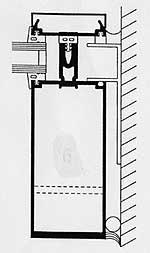Architectural Aluminum Curtain Wall Systems
"Fenestration Beyond Standards
Successfully integrating windows, storefronts, and curtain
walls
by David W. Altenhofen, CSI, CCS, AIA
Reprinted with permission of The Construction Specifications
Institute
99 Canal Center Plaza, Suite 300, Alexandria, VA 22314, from
The Construction Specifier
Documentation
The architect must prepare a set of construction documents indicating every requirement to allow for accurate bidding and construction. Documentation is crucial at the areas of most customization. For example, drawing detailed inside profiles of manufacturer's standard aluminum extrusions is a waste of time-the required exterior profile will suffice. On the other hand, half- or full-scale drawings indicating every material at the interface of window systems and adjacent construction are warranted. The construction documents must also include a specification carefully tailored to meet the unique requirements of the project. Using unedited, standard specifications for special project requirements is unacceptable.
Detailing
Standardized details prepared by the window or curtain wall manufacturer are almost never suitable for direct use on a project. In fact, many of them carry disclaimers stating the manufacturer is not responsible for the adequacy of the details provided for the joint between the window and wall system. The details a manufacturer presents generally meet only the lowest level of performance. (No manufacturer will risk losing business over more conservative installation requirements that make their product more expensive than the competition.)
As such, many manufacturer standard details show a simple, single line of sealant as the only method for keeping the joint between the window and the adjacent wall system watertight. Even resources like Architectural Graphic Standards only give generic information about the detailing of window or curtain wall systems. It is up to the architect to develop appropriate systems and details resulting in systems meeting performance criteria. (Refer to Figures 1 and 2 for an example of the difference between a manufacturer's standard jamb detail and the same condition customized to suit the project.)
|
|
The architect must consider several issues when detailing window, storefront, and curtain wall systems. Perhaps the most important is understanding whether the wall and window systems serve as rainscreen or barrier systems. By understanding the type of wall system and the functions of its various layers, it is possible to trace the continuity of thermal envelope, and moisture, air, and vapor barriers from the wall system, across the joint and onto the window, storefront, or curtain wall. It is also important to detail for realistic (i.e. imperfect) levels of performance within both the window systems and the interface with the adjacent construction.
It is doubtful the sealant applied in the field between dissimilar materials, and installed by different subcontractors, will perform perfectly for the life of the building. There will probably be gaps in the sealant at substantial completion, let alone in five, 10, or 20 years. Likewise, most storefront systems are designed to be watertight at the interior side of the glazing pocket, but in actual installed conditions, it is not unusual to see water penetrating farther towards the interior of the building than the glazing pocket. A reasonable solution is to detail sub-sill flashing with end dams with provisions for weeping any water harmlessly to the exterior.










